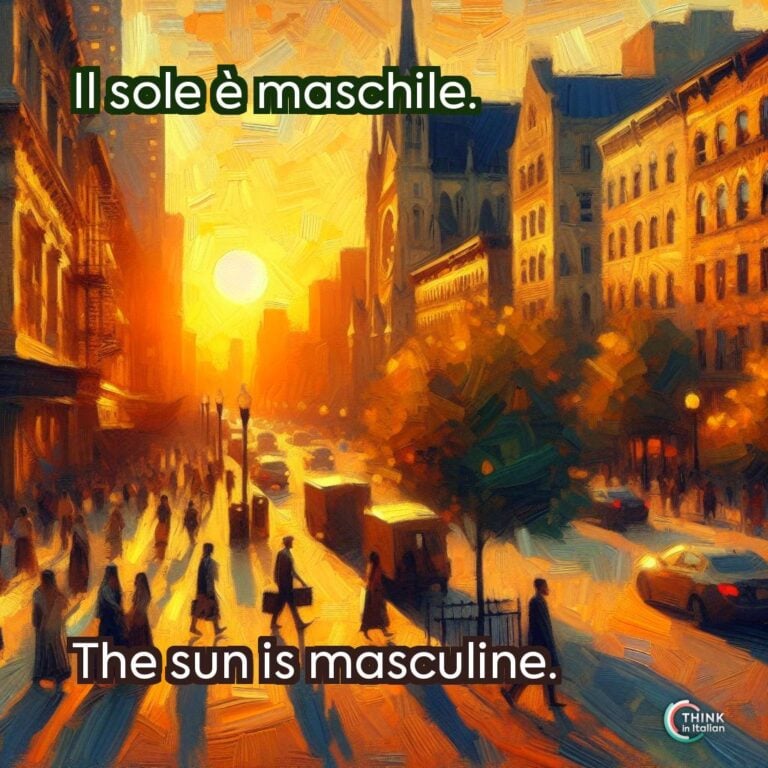Italian Nouns Ending in “e”
Common Patterns
Italian nouns ending in -e might be challenging because they don’t adhere to the standard gender patterns of nouns. These reckon on masculine nouns ending in -o and feminine nouns ending in -a.
On the contrary, Italian nouns ending in -e can be masculine, feminine, or even ambiguous. These patterns are largely determined by the suffixes of the nouns:
- Masculine -e nouns: nouns ending in -ore and -ale are typically masculine. For instance: il colore (the color), lo scrittore (the writer), il fiore (the flower); il canale (the channel), il giornale (the newspaper), il bracciale (the bracelet)
- Feminine -e nouns: nouns ending in -ione are typically feminine. For example: la nazione (the nation), la situazione (the situation), la televisione (the television), l’opinione (the opinion)
Recognizing Gender Through Context
When faced with uncertainty about a noun’s gender, context can provide essential clues. Definite or indefinite articles, adjectives, and sentence structure reveal the gender of these nouns.
Articles are reliable indicators of gender:
| Article | Masculine Singular | Feminine Singular | Examples |
|---|---|---|---|
| Definite | il/lo | la | il mare (the sea), la notte (the night) |
| Indefinite | un/uno | una | un ponte (a bridge), una chiave (a key) |
Adjectives must always agree with the gender of the noun:
- Masculine: il dolce sapore (the sweet flavor)
- Feminine: la dolce situazione (the sweet situation)
Nouns That Change Meaning With Gender
As it wasn’t tricky enough, some -e nouns have meanings that change depending on their gender.
As a linguist, I know this might be hard for learners, but I find it very interesting because it highlights the interplay between grammar and semantics in Italian. For example:
- Il fine (masculine): the aim or goal
Qual è il fine del progetto?
What is the aim of the project?
-
La fine (feminine): the end
La fine del film è stata sorprendente.
The end of the movie was surprising.
- Il fronte (masculine): the front (like a military front)
Il fronte si sposta a est.
The front is moving eastward.
- La fronte (feminine): the forehead
La fronte è coperta di sudore.
The forehead is covered in sweat.
This gender-dependent shift in meaning is rooted in the historical development of Italian, as these nouns often reflect distinctions that existed in Latin.
Nouns That can be Both Genders
In Italian, many nouns referring to jobs and professions are invariable in form, meaning they remain the same whether they refer to a man or a woman.
These nouns often end in -e, making them among the most versatile yet complex to use correctly. However, as you have learned by reading so far, the gender of these nouns can be understood by the context.
Here I will list some common job and profession nouns ending in -e that can be either masculine or feminine:
- Giudice (judge)
- Insegnante (teacher)
- Dirigente (manager)
- Cantante (singer)
- Docente (lecturer/professor)
- Assistente (assistant)
- Dipendente (employee)
- Paziente (patient)
- Agente (agent)
- Rappresentante (representative)
- Commerciante (merchant/trader)
- Dirigente (executive)
- Referente (contact person/reference)
- Cliente (client)
Another class of invariable Italian nouns ending in -e are present participles, which function as nouns to describe people based on actions or roles.
These nouns, derived from verbs, maintain their participial root while acquiring a nominal function. For example, insegnante (teacher) comes from insegnare (to teach), and cantante (singer) comes from cantare (to sing).
Again, the gender of these nouns is indicated through accompanying articles or adjectives, such as il cantante (the male singer) and la cantante (the female singer).
Historical Roots
The peculiarities of Italian nouns ending in -e trace back to Latin, the foundation of Italian. Latin classified nouns into three genders: masculine, feminine, and neuter.
In Latin, many nouns ending in -e were neuter. Over time, the neuter category merged into the others, creating the modern gender system of Italian.
For example, the Latin neuter mare retained its neuter characteristics but adopted a masculine article in Italian il mare (the sea), while the Latin feminine pax became la pace (the peace) in Italian, maintaining its feminine identity.
Latin suffixes shaped many of the patterns that we can observe in modern Italian and that I mentioned before:
- Nouns ending in -tionem became -zione (natio → nazione), retaining their feminine gender.
- Nouns ending in -orem became -ore (colorem → colore), typically masculine.
Latin also contributed to the ambiguity of some -e nouns. For instance, giudex (judge) evolved into il giudice (masculine) and la giudice (feminine), reflecting both grammatical gender and biological gender.
Most of the nouns for jobs and professions are both masculine and feminine
Understanding these historical developments provides deeper insights into why Italian nouns ending in -e can be so varied and irregular.
Master Italian Nouns Ending in “-e”
Mastering Italian nouns ending in -e involves a mix of understanding patterns, memorizing exceptions, and practicing in context. Here are some practical strategies:
- Pair nouns with articles
- Spot gender patterns
- Memorize exceptions
- Immerse yourself in context
- Use adjectives
Italian nouns ending in -e may seem unpredictable, but with practice and a clear understanding of patterns, exceptions, and historical roots, you can navigate them with confidence.




